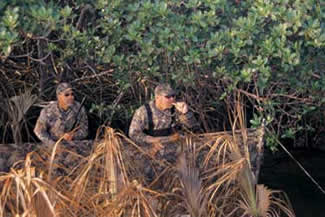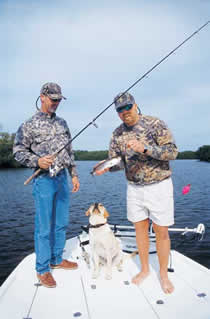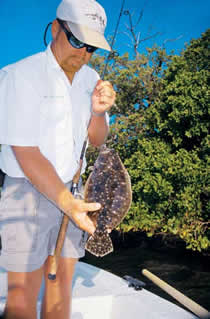November 17, 2014
By David Brown
From the duck blind to the redfish flats for an extra dose of cold season action.
Ask most sportsmen about the action on Tampa Bay and they'll say it's a “blast.” Practically speaking, that colloquialism usually starts with a “cast” to snook, redfish, trout and the like.

Tampa Bay duck hunter take aim over a palmetto frond blind and a decoy spread. |
However, the blast and the cast are often separate, but related, elements of a truly unique experience that mixes fins and feathers for what is locally called a “blast and cast” trip. An early morning duck hunt, followed by cool season fishing, provides a double dose of outdoors indulgence during a period when the bay sees an annual decline in activity.
Indeed, while many have cozied up to the TV, preferring football games over the meager pickings of late fall-winter fishing, Tampa Bay reveals its oft-overlooked gems of sporting potential. Those who seek, find more than meets the eye.
As with fishing, the hunting side often settles into a waiting game punctuated with sudden spikes in adrenalin. A lot of low crouching, neck craning and eye-squinting can lull you into lethargy, but mind and body snap into readiness the second those winged bowling pin silhouettes appear against the hazy sky.
KNOW YOUR TARGET
Florida hunters typically seek puddleducks such as bluewing and greenwing teal, wigeon, mottled duck (a.k.a. Florida mallard), pintail and resident greenhead mallards; and to a lesser extent, diving ducks like bluebill (scaup), ringnecks and mergansers. Preferred by most hunters, the primarily herbivorous diet of puddle ducks produces mild, tasty meat, while their shallow marsh and river habitation makes them easier to hunt.

In part two of a blast-and-cast day, a retriever judges a seatrout a little on the short side. |
Conversely, divers feed on baitfish and mollusks so theirs is usually a gamier flesh. Moreover, their affinity for open water means a broader search.
Capt. Chet Jennings, who runs blast and cast trips out of Shell Point Marina in Ruskin, said the Florida mallard generally takes top billing for sport and tablefare. A wily bird, this one is tough to fool. And as the largest of the puddleducks, it yields a hefty portion of highly prized meat. Only downside is the daily bag limit of one per person—a point easily missed in an unrestrained flurry.
“Identifying these birds in flight is very important,” Jennings said. “You have to have a little bit of experience and know-how so you're not shooting over your limit. If you just start blasting ducks out of the sky, you could end up in a very bad spot.
“It takes a little study to know the difference. That's my job, to tell clients when to shoot.”
Like fighter pilots memorizing aircraft outlines, experienced hunters learn to detect subtle identifying elements of a duck's shape and flight pattern, even when distance blurs coloration. One resource for waterfowl identification is www.ducks.org.
WHEN & WHERE
The open waters of Old Tampa Bay, particularly the expanses south of the Courtney Campbell Causeway (Hwy. 60) hold vast numbers of diving ducks during winter, but lower Tampa Bay's extensive backwater systems such as the mouths of the Alafia and Manatee rivers, as well as Cockroach Bay and Bishop's Harbor, offer tremendous puddleduck habitat.
The same flats boats used for snook, redfish and trout pursuits will suffice, but during low tide, airboats excel at scooting over treacherously skinny spots and into waterfowl wonderland. Much of this game involves tromping through chilly water, so you'll need neoprene chest waders. Stocking foot styles used with separate wading boots are best, as this allows you to shed the waders if the weather warms.
Unlike well-defined fishing holes, locating good duck spots is more a function of watching and patterning the birds. Look for food sources like tender shoalgrass (thin blades), fresh water and plenty of nearby roosting spots. Subsequent years typically see at least some regularity of return, so keep a thorough hunting log.
“It's like anything else, you got to go out and beat the bushes,” Jennings said. “See what you can find, and remember what you see. Take in all the elements like water depth, wind direction and vegetation. Then go out and try to find that pattern in other places.”
For early hunts, you should be ready to shoot at least 15 minutes before sunup. With ducks flying in and looking for food, any commotion will alert them to your presence. Once the birds make their daybreak move, they may sit down for several hours, so if you're not set up early enough, you may miss the morning action.
Evenings can also prove productive, as ducks come in for a late-day feed and then head for their evening roosts. Positioning along the birds' travel lanes affords you the chance to shoot them coming and going.

Flounder suggest the spirit of duck hunting: Don came, hunker down and keep a lookout for prey passing overhead. |
Optimal conditions include puffy winds and cloudy skies and a light rain. Basically, when the birds are getting blown around, they're more apt to settle into a calm shoreline. Also, low light hinders their vision. On bluebird days, the hunt's over a couple of hours after sunup, whereas nasty weather allows you to hunt until you get your fill.
In any conditions, masters of waterfowl psychology leverage the old safety in numbers theory by arranging a couple dozen decoys within shooting range of their position. Ducks will bunch up in adverse conditions, but new arrivals instinctively seek out new neighbors to help them locate food, water and roosting areas.
As a biologist with the Florida Fish and Wildlife Conservation Commission, Eric Johnson spends a lot of time studying wildlife. He's also spent many hours in a duck blind from Florida to New England. Ducks are ducks, he said, but when they arrive in the migration can greatly affect their reactions.
In contrast to northern environs, where Johnson said he has called indecisive ducks for up to five minutes, calls comprise a lesser element of Florida hunts. The fact is, duck calls in the Sunshine State usually fall on suspicious ears.
“By the time ducks migrate down to Florida,” he said, “they've passed through a lot of decoy fields and they've been shot at and called at, so they're pretty wise by the time they get here. Traditionally, down here, ducks either come in right away or they just ignore you and keep on going.”
Jennings notes, “If you're where they want to be and you have decoys out, you won't need to call them. They'll come right to you.”
THE ART OF CONCEALMENT
Defying geographic boundaries is this duck-hunting postulate: Those suckers have incredible eyesight. Hence, the need for full camouflage outfits, hats, gloves and face nets (or camo grease paint).
Some hunters shoot from johnboats rigged with tent blinds. Jennings stakes out a promising mangrove island, erects a makeshift fence line by sinking palmetto fronds into the mud and then hangs camouflage netting along the foliage.
Wherever you hide, you gotta sit still.
“A lot of hunters get antsy in the blind,” Jennings said. “They want to get a better position, or adjust their seat, but that'll ruin the whole thing. If you start bobbing your head or moving around, the ducks can see that motion. When they're coming in to land, that's their most vulnerable time and they know that. So they'll key in on the movement.”
Good shooting form starts with patience and ends in fluid motion.
“Be as still as you can, then stand up, mount the gun and take your shot in one movement,” Jennings said. “This gives you time to get multiple birds, because they all have to get back in gear and get going back up.
“Also, make sure the duck is in range so you don't just wound it. If a wounded duck flies away, no one will get to harvest that bird except the raccoons, foxes or whatever finds him.”
BAG YOUR BIRD
Jennings suggests 28- to 12-gauge pump-action or semiautomatic shotguns and No. 6 or 7 1/ 2 shot. Heavier shot materials like bismuth and tungsten maintain their velocity better than steel, thereby affording greater range and killing power.
Shells with high-end shot cost more, but as Jennings notes: “You invest all this time, effort and money into duck hunting, why skimp on the load that's actually going to bring the duck out of the sky? Also, you're going to wound fewer ducks with quality shot.”
Many hunters who go with less-expensive steel say that it's best to choose shot one size larger than what you may have used back when lead shot was legal: No. 4 instead of 6, for instance.
Essential to this game is a good bird dog. Not only does your canine companion save you a lot of walking, but quickly retrieving birds ensures a direct and humane dispatching for those still kicking.
Work with your dog during the off season to eliminate “hard mouthing,” which damages the meat. Also, establish discipline and control to ensure your dog can keep its cool when ducks flare into the decoys. In the field, carry plenty of fresh water to rinse the dog's face—salty or brackish water will irritate their eyes and mouth.
BEND A ROD
After a morning of duck dunking, Jennings swaps his shotguns for spinning rods and heads for productive mangrove shorelines, backwater cuts and grassflats. The usual target is redfish lying in sandy potholes or tailing on shallow grassflats. When transitioning from hunting directly into fishing, Jennings advises keeping your waders on and pursuing reds on foot. Weedless gold spoons, or white jerkbaits rigged weedless on a 2/0 or 3/0 worm hook are ideal for this pursuit.
On winter's super low tides, trout, reds and the occasional snook will get locked into deep troughs way back in the mangrove basins. With mere puddles between navigable waters and these fantasy fish bowls, your choices are A) hike through several hundred yards of mud or B) zip across treacherous shallows in an airboat. When you reach these holes, shrimp fished under corks, jigs and topwater plugs can yield tremendous results.
Truth be told, a blast and cast trip is somewhat of a Catch-22, as ideal weather for hunting (windy, cloudy and cold) and fishing (calm, clear and warm) rarely overlap. But you have options. If the day favors duck hunting, spend more time in the blind and watch for windows of angling opportunity. Conversely, if chamber of commerce weather emerges, you can always count on first-light duck action, then wrap up early and spend the day casting.
Good thing is, you'll have very little traffic during duck months. Unlike the parking lot of spring snook season, fewer boats exploit winter's meager opportunities.
“This a nice break from the traditional stuff you do 90 percent of the year,” Jennings said. “It's a great opportunity to get outside and enjoy some sporting activities. The game's not over in the winter, it's just played differently.”
Waterfowl Regulations
License: Florida hunting license plus a Federal Duck Stamp and Migratory Game Bird Permit.
Shooting Hours: One-half hour before sunrise to sunset.
Daily Bag Limit: Six ducks. May consist of no more than one black duck, one mottled duck, one fulvous whistling duck, one pintail (only during the pintail season), one canvasback (only during the canvasback season), two redheads, two wood ducks, three scaup, four scoters and four mallards (no more than two may be females). The daily bag limit (if you want to take it!) for coot is 15 and for merganser, five.
Where to Hunt: Statewide regulations (available on MyFWC.com/hunting) apply, but for Tampa Bay-area restrictions that apply to spoil islands, port areas and others, call the FWC's Tampa Field Office at (813) 272-2516.
Shooting Safety
Slippery mud, cramped spaces and firearms can be the recipe for disaster without clear attention to safety. Key points include:
- Confirm your ammo: Different gauge shells can fit in the same gun, but with very dangerous results. During a flurry of activity make sure you know what you're grabbing. When adjacent hunters shoot different gauges, isolating everyone's ammo is a must.
- Muzzle Discipline: Ducks don't follow scripts and when a bird suddenly drops in low, sweeping your muzzle past a fellow hunter's head turns everyone's blood cold. Shooting near a partner's head will make his ears ring worse than any rock concert. Best protection is to keep all hunters on a line so no one is ever downrange by even a foot.
- Wader Wisdom: They'll keep you warm and dry, but they'll also take you to the bottom if they fill up with water. Step cautiously in waders and never venture so far that you're unreachable in the event of an accident.
- In the Boat: Never travel with a loaded gun—period. In an airboat, anything that flies out of pockets and into the fan will shatter, or explode in the case of shotgun shells. Even if no one gets hit, prop or hull damage can end the trip in a hurry.
- Be Kind to Retrievers: It's not unheard of for ducks to drop in while the dog is fetching a fallen bird. Even if it costs you a certain shot, never shoot with the dog downrange. Tampa Bay guide Chet Jennings: “I tell guys, my dog is $800 if you shoot her.”
- Public Relations: Be cautious and courteous, mindful that you may be sharing the waters with fishermen and others unfamiliar with waterfowl hunting protocol. Hurling angry words at a boater who inadvertently nears your decoy spread is no way to foster good public relations for our sport. Use a simple signaling device like an airhorn to grab their attention. Be a safe hunter and a good ambassador.
FS
First Published Florida Sportsman Dec. 2004

